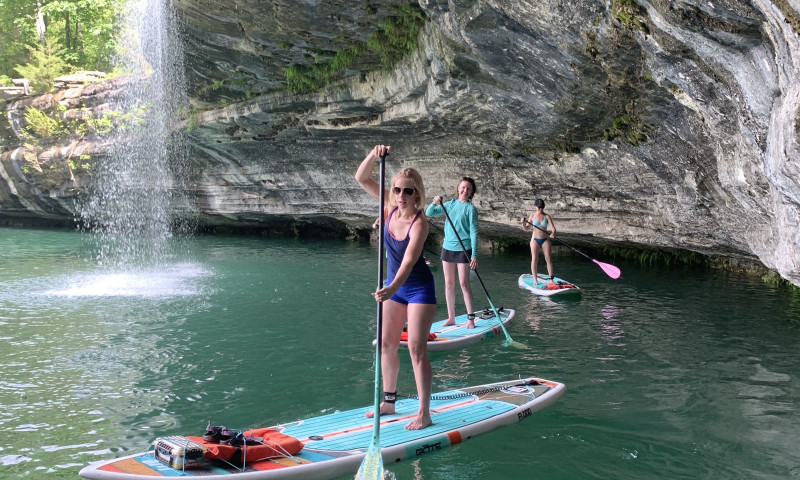Boating
or Floating
Arkansas is made for those who love life on the water-- whether you crave the rush of a motorboat on a glassy lake, the surge of rapids in a kayak, or the slow drift of a canoe on a lazy current. The Natural State has more than 600,000 acres of lakes and 90,000 miles of rivers and streams ready to explore.
Lakes stretch wide under open skies, rivers wind past towering bluffs, and quiet bayous hide pockets of untamed beauty.
Need gear? Whether you’re looking to rent a kayak for the day, pick up a wakeboard, or invest in your own bass boat, you’ll find plenty of options. From jet skis and pontoons to SUP boards and scuba gear, retailers and rental shops across the state make it easy to gear up and get on the water.

Flow With It
Arkansas rivers let you ride the rush of whitewater, cast for trout in world-class fishing waters and drift through quiet backcountry. From rugged multi-day river treks to gentle waters perfect for first-time paddlers, there’s a float trip for every kind of adventurer. Zip up your life jacket—Arkansas adventure awaits around every bend.
Wander the Water
Arkansas’ lakes shine in every season, drawing boaters, anglers, and water lovers to their shores. Beneath the surface, some of the country’s clearest waters invite you to scuba dive and explore underwater landscapes. Swim, fish, boat, or simply soak up the sun—however you wander, Arkansas waters are calling.
Sponsored Content
Things
to Do
Boating & Floating
Where can Arkansas take you?
From unmatched outdoor escapes to world-class museums, amazing food, historic adventures and more. Find your next getaway in The Natural State.
Feeling Adventurous?

Boating & Floating Listings
Floaters and Boaters Resources
Ten Important Reminders for Canoe, Raft, and Kayak Safety
-
Life jackets are essential to raft, kayak and canoe safety–wear them.
-
Take along a spare paddle.
-
Pay attention to local weather forecasts.
-
Dress appropriately for the season.
-
Don't travel alone–always have a raft, kayak or canoe safety partner.
-
Avoid camping in areas subject to sudden rises.
-
Know your ability and don't exceed it.
-
Refrain from drinking creek or river water no matter how clean it appears.
-
Carry out whatever you carry in.
-
Should you capsize, try to stay with your boat and swim it to shore, making certain that you're on the upstream side of the craft to avoid getting pinned between it and rocks or willows.
Securing Your Belongings
It’s important to secure your gear in the boat in case you flip—also known as tumping, swamping, tipping, or rolling. You don’t want your dry clothes, phone, or snacks drifting down the river, and neither does the environment. Bungee cords and carabiners are your best friends.
If you bring a cooler, don’t just tie it in—secure the lid to keep food and drinks from spilling if you tump. And remember, glass containers are not allowed in vessels easily susceptible to tipping within the banks of Arkansas’ navigable waterways.
If you’re floating with food or drinks, you’re also required to have a closable, attached trash container. Most paddlers and outfitters use a mesh bag with a drawstring.
Paddling Ethics
Many streams have gravel banks where you can pull off to stretch your legs or grab lunch, but most riparian land remains privately owned. Respect private property along navigable streams and avoid stopping unless it’s an emergency. Fences, signs, or purple paint may mark private land. Keep noise levels low and plan your stops on public land.
When approaching anglers or other paddlers, give them space and avoid disrupting their experience. Arkansas’ waterways belong to everyone—courtesy goes a long way.
Classification of Rapids
-
Class I: EASY--Moving water with few riffles and small waves. Few or no obstructions. Correct course is easy to determine.
-
Class II: MEDIUM--Fairly frequent, but unobstructed rapids. Course generally easy to recognize. Some maneuvering is required.
-
Class III: DIFFICULT--Numerous rapids with high and irregular waves. Narrow passages that often require complex maneuvering. Course not always easily recognizable.
-
Class IV: VERY DIFFICULT--Long rapids characterized by high and irregular waves with boulders directly in swift current. Course often difficult to recognize requiring some scouting from bank.
-
Class V: EXCEEDINGLY DIFFICULT--Continuous rocky rapids with high and irregular broken water which cannot be avoided. Extremely fast flow, abrupt bends, and strong cross currents. Class V river ratings present difficult rescue conditions. Frequent inspections from bank necessary.
-
Class VI: LIMIT OF NAVIGABILITY--Class V difficulties increased to the upper limits of skill and equipment. Extremely dangerous. This classification of rapids is for teams of experts only.























